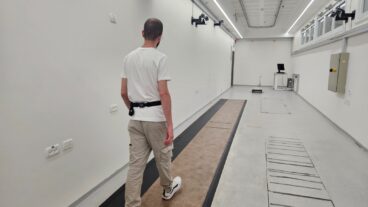Prof. Rafael Beyar and colleague Dr. Genia Nikolsky, director of research in interventional cardiology, in the Rambam Medical Center’s Catheterization lab.Cardiologists from Rambam Medical Center in Haifa have proven for the first time that a prototype hybrid device combining a computerized tomography coronary angriography (CTCA) with an advanced nuclear camera (single-photon emission computed tomography, or SPECT) can be much safer and more accurate in determining whether patients with chest pains need invasive treatment to prevent a heart attack.
An article by Rambam director-general and cardiology Prof. Rafael Beyar and colleagues from Rambam, the Technion’s Rappaport Medical School and General Electric Healthcare Technologies-Israel has just been published in the on-line edition of the world’s leading heart research journal, the Journal of the American College of Cardiology (JACC).
An accompanying editorial by Prof. William Wijns of the Aalst Cardiovascular Center in Belgium praises the Israeli research in an article subtitled: ‘A Glimpse Into the (Near) Future?’ Wijns, president of the European Cardiology Society and one of the world’s leading cardiologists, says it is an international achievement that “represents another validation milestone in the search for a non-invasive imaging strategy that will eventually provide integrated evaluation of anatomy and physiology in patients with coronary artery disease.”
One of GE Healthcare’s hybrid devices was installed at Rambam, and another at a leading clinical cardiology institute in the United States. Rambam completed a comparative study with 130 of patients suffering from chest pains who were examined with both the hybrid, non-invasive device and invasive catheterization. The prototype device examines the heart muscle and maps the flow of blood inside it in one examination.
The innovative technology, which the researchers and the editorial said was sure to become the standard, provides an accurate diagnosis of clogged coronary arteries – the same level as that in invasive catheterization, but much more accurate than that from ordinary CT imaging of the heart alone. This will make many diagnostic catheterizations – which pose risks to the patient – unnecessary, they said.
The Rambam researchers have received a “flood” of congratulations from cardiologists and imaging specialists from around the world since the articles appeared in the JACC journal.
Invasive insertion of a catheter into the heart’s coronary arteries via a vessel in the groin or the wrist presents some risks. In recent years, CTCA has been developed to provide anatomical information about the arteries that supply blood to the heart muscle. But this examination does not provide information about the physiological significance (the amount of disruption in the blood supply) of the narrowed artery.
An additional technology is the SPECT, which makes possible an assessment of blood flow to the heart muscle when the patient is at rest and active so that the healthy, damaged and scarred regions of heart muscle can be identified. But this device cannot be used optimally alone.
Rambam and GE combined to develop and test the first hybrid device that conducts both CTCA and SPECT in one examination. Beyar said the new development is a “breakthrough in diagnosis of heart disease. [We] can know better before catheterization if there is disease in the arteries and how best to treat it. This is more important than ever, after evidence of [clotting] risk from drug-eluting stents.”
Rambam cardiologist Dr. Shmuel Rispler said, “Not all cases of narrowed coronary arteries require intervention since they may have completely normal blood flow. But when you discover coronary arteries that arouse concern by being more than 50 percent blocked, you have referred the patient until now for an invasive catheterization, in which the anatomy (narrowed arteries) is compared with the physiology (quality and speed of blood flow). In many cases of catheterization, you find that blood flow is completely normal and there is no need for intervention.”
(Reprinted with the permission of The Jerusalem Post)












